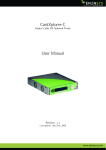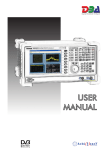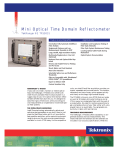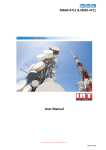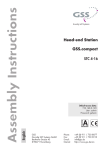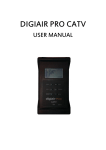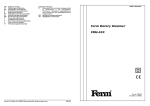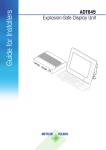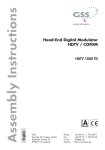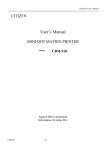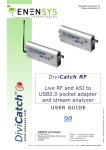Download DMA120, DMA121 Digital Modulation Analyzers
Transcript
DMA120, DMA121 Digital Modulation Analyzers 64 and 256QAM Analysis In-service Digital Channel Performance Verification Measurements at an Affordable Price Measurements Compliant with DVB (ETSI) Standard ETR290 Troubleshooting Aided by Constellation, Spectrum, and Equalization Display Modes Most Measurements Require Only Two Keystrokes Pass/fail Indication Reduces Training Requirements for Technicians New to Digital Signal Measurements PC Card (PCMCIA) Slot for Easy Memory Expansion Small and Light Weight Easy-change Battery Affordable, portable, ready for cable system technicians: digital channel 64 and 256QAM transmission performance verification measurements The DMA120 Series Digital Modulation Analyzers provide answers to nagging questions about how to test and verify performance of your digital plant. Quantification of digital transmission performance – at any point in your system – will greatly enhance technical management and decision making. The DMA120 provides analysis of ITU-T-J.83, Annex B 64 and 256QAM and the DMA121 verifies 64 and 256QAM formatted per DVB-C. Copyright © 1999 Tektronix, Inc. All rights reserved. The DMA120 Series provides the intelligence cable TV technicians need to efficiently install and maintain HFC distribution plant using 64 or 256QAM transmission. Measurement results provide a clear picture of system performance, minimizing the need to re-visit an installation site or make additional service calls. The DMA120 Series field tools are housed in a rugged, weather resistant package and are powered by an easy-to-change NiMh battery. Standard accessories include a protective soft case, mains power supply, and user’s manual. Figure 1. MER and Estimated Noise Margin screen. Figure 2. BER screen. Qualify System Performance The built-in digital demodulator makes possible in-service measurements of: • Modulation Error Ratio (MER) • Error Vector Magnitude (EVM) • Estimated Noise Margin • BER before Reed-Solomon (R-S) decoder • Estimated BER after R-S decoder with system availability statistics page 2 Modulation Error Ratio (MER): ETSI ETR290 indicates that MER is the best overall “figure of merit” measurement to determine QAM signal quality. Although bit error rate (BER) has been widely addressed as an important digital transmission “figure of merit” measurement, MER provides a much earlier indication of transmission impairments. MER indicates the ratio of average total signal power in the ideal constellation to average error power in the constellation as received by the DMA120 Series. The measurement includes error power due to any impairment. If the only impairment in the test channel spectrum is noise, MER is equal to signal-to-noise. Technicians will feel familiarity with MER because results are expressed in dB, similar to analog transmission carrier-to-noise or signal-to-noise measurements. The DMA120 Series measurement screen (see Figure 1) shows MER vs. time, providing trend information. Error Vector Magnitude (EVM): EVM is an alternative “figure of merit” measurement. It has been a performance measurement for digital communication systems in the past and provides a means of system comparability for some engineers. The same distortion elements are measured as in MER. However, the calculation of error is different and is expressed as a percentage (%) of the maximum voltage in the constellation (at sampling times) as received by the DMA120 Series. Estimated Noise Margin: The legacy of rf broadband system maintenance has been based on measurements in the frequency domain. Technicians are conditioned to thinking of system “headroom” in terms of dB carrier-to-noise or dBc for CSO, CTB, or cross modulation. Estimated Noise Margin indicates the “headroom” for digital channels and results are reported in dB, similar to legacy analog measurements. Essentially, simulated gaussian noise is added to the input signal until a critical pre-FEC BER of 10–4 is measured. The added, simulated noise equals the Estimated Noise Margin which answers the question, “how many dB until subscribers are receiving impaired digital services?” Bit Error Rate (BER) before Reed-Solomon (R-S) decoding: BER is an important measurement to document system performance. The typical system operating goal is to achieve a BER of 10–9. Service impairment will typically be observed at bit error rates greater than 10–4. The BER measurement is the average ratio of bit errors to total bits received in a specified time period. The DMA120 Series BER measurement may be set for any period from 1 to 60 minutes. Results from successive periods can be compared to show a 24-period trend. Figure 3. Spectrum mode. Figure 4. Constellation display mode. Estimated BER after R-S decoding: BER after R-S decoding represents the service level that the cable system is providing to the subscriber’s TV receiver or computer. The R-S decoder is typically able to correct errors up to an input BER of approximately 10–4. Beyond this value, uncorrected errors pass through the decoder – this is the value reported by Estimated BER (see Figure 2). System availability statistics are also reported by the DMA120 Series, including: • Errored seconds (number of seconds that include an errored block) • Severely errored seconds (one-second periods with greater than specified number of errored blocks) • Severely disturbed periods (duration of sync loss) • System unavailability time (time period containing at least 10 consecutive severely errored seconds) System availability statistics are very useful for tracking intermittent impairments that may not be observable based on MER or average BER measurements. Maintain and Troubleshoot Your Digital Video Plant When performance quality measurements indicate transmission problems, the DMA120 Series can provide assistance to find out what’s wrong. Additional measurements and display modes that can help the technician include: • Channel Average Power (Signal Level) • Adjacent Channel Levels • Spectrum Display Mode • Constellation Display Mode with zoom capability • Adaptive Equalizer Display Mode Digital Channel Average Power: RF signal level measurement is made by integrating all the channel power through a channel bandwidth IF filter. A user-settable offset is available to accommodate probe loss. The Signal Level measurement screen plots signal levels vs. time, providing a convenient display from which to make gain or attenuation adjustments or judge other variables that can impact signal level. Adjacent Channel Levels: Potential interference to adjacent channels can be verified using this measurement. The Adjacent Channel Levels display compares the test channel average power to the average power in each of the two higher and two lower adjacent channels. The measurement results screen includes a bar graph comparing the test channel and adjacent channels power. This measurement may be used to check flatness across five channels or verify spectral purity of a QAM modulator. Spectrum Display Mode: The channel or system spectrum can be viewed in this mode – channel symmetry and flatness, and relative signal levels can be visually confirmed (see Figure 3). Constellation Display Mode: Digital modulation quality can be visually estimated by viewing the constellation of the transmitted signal (see Figure 4). Distribution impairments can be identified including noise and coherent interferers or modulator impairments such as I/Q imbalance or quadrature error. The DMA120 Series also includes two zoom modes – a constellation quadrant view and a single constellation box can be selected to closely examine the distribution of symbol landings. Decision boundaries are displayed along with adjacent boxes to make it easy to see the symbol landing patterns (see Figure 5). page 3 Figure 5. Constellation Box Evaluate mode. Adaptive Equalizer Display Mode: This display indicates linear impairments such as poor frequency response and reflections. Tap values show how hard the equalizer is working to compensate for impairments. The display includes a bar graph which compares the values of the different taps against a DVB template. Bars approaching or exceeding the template value indicate that there is noticeable system impairment detected at the test point. New Measurement Technology That’s Easy-to-Use Using the DMA120 Series is easy. Most measurement functions are no more than two menus deep. Navigation through menus is straight forward and there’s a MENU key on the front panel that instantly gets the user to the instrument’s Main Menu screen. Universal set up page 4 parameters are part of a Set Up screen. Measurement specific set up parameters are part of the individual measurement screens. Digital transmission is new to most cable TV system technicians and so are measurements to verify performance. Technicians may not understand exactly how these measurements function or how to interpret measurement results. However, measurements are still required to continue system installation and maintenance activities. The DMA120 Series helps technicians to continue working by providing measurement pass/fail indicators. The system engineer or chief technician can determine the measurement-result threshold values. This enables the technician to continue working if measurements are passing or follow an Engineering directive if failures are encountered. Pass/fail indicators are available for: MER, RF Signal Level, Adjacent Channel Level, Channel Power-to-Noise, Severely Errored Seconds (BER mode). Status indicators also help clarify measurement conditions: the DMA120 Series notes if it’s locking to the incoming QAM signal and also if it’s locking to the R-S decoder output. The actual received symbol rate is also reported. Operating Convenience The DMA120 Series uses a moisture– and dust-proof keypad. It uses a high-resolution LCD display with backlight. Contrast controls are conveniently located on the front panel. The DMA120 Series includes many capabilities designed to simplify the job of digital plant installation and maintenance. Ancillary enhancements include: • Print screen: Any measurement or display mode screen can be directly printed via RS-232 interface • Up to 30 constellations or 100 other measurement results can be stored in internal memory with realtime clock/date stamp, measurement site name, operator name, and ambient temperature • User-changeable input adapter (type F or BNC – optional accessory) • PC Card (PCMCIA) input for 2 and 20 Megabyte memory cards to store additional measurement results and/or system channel tables • User-changeable, NiMH battery to extend the operating day; battery capacity indicator; user-selectable automatic power down DMA 120 Series Characteristics NOTE: All specifications apply across the operating temperature range (–5 to +40°C) unless otherwise stated. All values refer to measurement after 25-minute warmup. All power measurements referenced to 75 Ω impedance. RECEIVER Frequency Range (channel center frequency) – DMA120: 54 to 860 MHz. DMA121: 50 to 866 MHz. Resolution Bandwidths (typical) – DMA120: 135 kHz, 6 MHz. DMA121: 135 kHz, 8 MHz. Input Impedance – 75 Ω, nominal. Maximum Input – RF Power: 120 dBµV (60 dBmV). AC Volts: 90 V peak. Distortion-free Dynamic Range – >40 dB. Sensitivity – <20 dBµV (–40 dBmV). DISPLAY MODES Spectrum – Displayed Level (average power of 64QAM signal at 6.875 Msymb/s): Minimum: 40 dBµV (–20 dBmV). Maximum: 100 dBµV (40 dBmV). Attenuation Steps: 5 dB, typical. Attenuation Range: 35 dB, typical. Vertical Scale: 10 dB/div, 10 to 90 dBµV, –50 to 30 dBmV, –100 to –20 dBm. Span Settings: 2 to 824 MHz (fixed to 135 kHz RBW). Flatness: ±1 dB. Constellation – Sizes: 64QAM, 256QAM. Evaluation: Full constellation, quadrant, single point (box). Adaptive Equalizer – Number of Taps: DMA120: 8 feed-forward; 8 feed-back. DMA121: 8 feed-forward; 24 feed-back. Scale: +10 to –40 dBc. Mask: DVB. MEASUREMENT MODES Signal Level – Channel Bandwidth: DMA120: 6 MHz. DMA121: 8 MHz. Level (channel average power): Minimum: 40 dBµV/–20 dBmV. Maximum: 100 dBµV/40 dBmV. Accuracy: 64QAM: ±1.5 dB, referenced to 25°C. 256QAM: ±1.8 dB, referenced to 25°C. Reference Units (selectable): dBµV, dBmV, dBm, dBpW. Pass/Fail Indication: User-adjustable threshold. In-service Measurement. Channel Power-to-Noise – Channel Bandwidth: DMA120: 6 MHz. DMA121: 8 MHz. Maximum Ratio: 40 dB. Accuracy: ±2.1 dB. Pass/Fail Indication: User-adjustable threshold. In-service Measurement: Noise measurement frequency out of channel. Adjacent Channel Level – Difference Amplitude Range: DMA120: +10 to –25 dB. DMA121: +15 to –25 dB. Accuracy: ±2.1 dB referenced to 25°C. Display Vertical Scale: 40 to 100 dBµV, –20 to 40 dBmV, –65 to –5 dBm, 25 to 85 dBpW. Pass/Fail Indication: User-adjustable threshold. In-service Measurement. Modulation Error Ratio (MER) – Range: 64QAM: 22 to 35 dB. 256QAM, DMA120: 28 to 35 dB. 256QAM, DMA121: 30 to 35 dB. Accuracy: ±1.5 dB at 65 dBµV/5 dBmV, referenced to 25°C. Pass/Fail Indication: User-adjustable threshold. In-service Measurement. Error Vector Magnitude (EVM) – Range: 64QAM: 1.2 to 4.1%. 256QAM: 1.1 to 1.9%. Accuracy: ±0.4% over 1.2 to 2.0% range; ±0.8% over 2.1 to 4.1% range at 65 dBµV/5 dBmV. In-service Measurement. Average Bit Error Rate (BER), Before R-S Decoding – Range: 64QAM: 10–4 to 10–9. 256QAM, DMA120: 10–4 to 10–8. 256QAM, DMA121: 10–4 to 10–6. User-selectable Time Period: 1 to 60 minutes. Number of Periods Comparable: 24. In-service Measurement. Estimated Average Bit Error Rate (BER), After R-S decoding – User-selectable Time Period: 1 to 60 minutes. Number Periods Comparable: 24. In-service Measurement. System Availability Statistics – User-selectable Time Period: 1 to 60 minutes. Errored Seconds. Severely Errored Seconds: Pass/Fail indication: User-settable threshold. Unavailable Time. Severely Disturbed Period. In-service Measurement. Estimated Noise Margin – Range: DMA120: 64QAM – 1 to 12 dB, 256QAM – 2 to 7 dB. DMA121: 64QAM – 1 to 10 dB, 256QAM – 3 to 5 dB. Accuracy: ±1.5 dB at 65 dBµV/5 dBmV. Symbol Rate – Range: DMA120: 5.057 to 5.360 Msymb/s. DMA121: 5.000 to 6.956 Msymb/s. page 5 ENVIRONMENTAL DMA 120 Series Characteristics Continued PHYSICAL CHARACTERISTICS Temperature – Operating: –5 to +40°C. Altitude – Operating: Up to 4,600 m (15,000 ft.). Non-operating: Up to 15,000 m (50,000 ft.). EMC COMPLIANCE Qualified Per The Following Standards – U.S.A./FCC: CFR 47, Part 15, Subpart B, Class A. Australian EMC Framework: AS/NZS 2064.1/2. EU (EMC Directive 89/336EEC): EN 55011 Class A. IEC 1000-4-2 (ESD immunity). IEC 801-3 (RF field immunity). IEC 1000-4-4 (EFT/burst immunity). POWER DC Input Range – 12 V, 2 A. Battery Run Time – >2.5 hours, typical. Battery Charge Time (instrument off) – 4 hours, typical. page 6 Dimensions cm in. Height Width Depth 32 17 6 12.5 6.75 2.25 Weight kg lb. Net 2.1 4.6 WARRANTY One year parts and labor. OTHER Communication Interface – RS-232, speed 9600 to 115,200 baud. Channel Tables – User-defined tables in standard memory. Additional stored in PC Card (PCMCIA) memory cards. DMA 120 Ordering Information DMA120 DMA120 Series Recommended Accessories Digital Modulation Analyzer for ITU-T-J83, Annex B 64QAM. DMA121 Digital Modulation Analyzer for DVB-C 64QAM. Both Include User’s Manual, Reference Card, Padded Carrying Case, 120 VAC North American Power Pack with DMA120, 220 VAC Euro Universal Power Pack with DMA121, Precision Female-Female Type F Adapter,Vehicle Power Adapter, Channel Table Loader Software with Manual, RJ45 to 9-pin Adapter, RJ45 Cable. Type F-to-BNC Input Adapter – 103-0310-00. Additional Battery – DMABAT. External Battery Charger for DMABAT – DMACHG (specify power cord Option A2 or A3, as applicable). Thermal Printer – DMAPRN. Includes: Five Rolls Paper, Battery, AC Adapter. Select one of following AC Adapter options: Option A0 – North American 115 V, 60 Hz. Option A1 – Euro Universal 220 V, 50 Hz. DMA120 Series Options Option C3 – Three years calibration services. Option C5 – Five years calibration services. Option R3 – Three years post-warranty repair protection. Option R5 – Five years post-warranty repair protection. AC Adapter Options Option A0 – North American 115 V, 60 Hz (standard with DMA120). Option A1 – Euro Universal 220 V, 50 Hz (standard with DMA121). Option A2 – U.K. 240 VAC, 50 Hz. Option A3 – Australian 240 V, 50 Hz. page 7 For further information, contact Tektronix: Worldwide Web: for the most up-to-date product information visit our web site at: www.tektronix.com ASEAN Countries (65) 356-3900; Australia & New Zealand 61 (2) 9888-0100; Austria, Central Eastern Europe, Greece, Turkey, Malta,& Cyprus +43 2236 8092 0; Belgium +32 (2) 715 89 70; Brazil and South America 55 (11) 3741-8360; Canada 1 (800) 661-5625; Denmark +45 (44) 850 700; Finland +358 (9) 4783 400; France & North Africa +33 1 69 86 81 81; Germany + 49 (221) 94 77 400; Hong Kong (852) 2585-6688; India (91) 80-2275577; Italy +39 (2) 25086 501; Japan (Sony/Tektronix Corporation) 81 (3) 3448-3111; Mexico, Central America, & Caribbean 52 (5) 666-6333; The Netherlands +31 23 56 95555; Norway +47 22 07 07 00; People’s Republic of China 86 (10) 6235 1230; Republic of Korea 82 (2) 528-5299; South Africa (27 11)651-5222; Spain & Portugal +34 91 372 6000; Sweden +46 8 477 65 00; Switzerland +41 (41) 729 36 40; Taiwan 886 (2) 2722-9622; United Kingdom & Eire +44 (0)1628 403300; USA 1 (800) 426-2200. From other areas, contact: Tektronix, Inc. Export Sales, P.O. Box 500, M/S 50-255, Beaverton, Oregon 97077-0001, USA 1 (503) 627-6877. Copyright © 1999, Tektronix, Inc. All rights reserved. Tektronix products are covered by U.S. and foreign patents, issued and pending. Information in this publication supersedes that in all previously published material. Specification and price change privileges reserved. TEKTRONIX and TEK are registered trademarks of Tektronix, Inc. All other trade names referenced are the service marks, trademarks or registered trademarks of their respective companies. 5/99 HB/XBS 21W-12235-2









